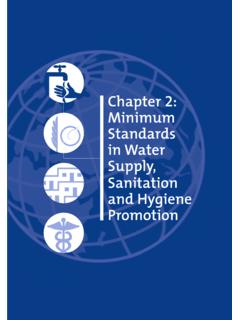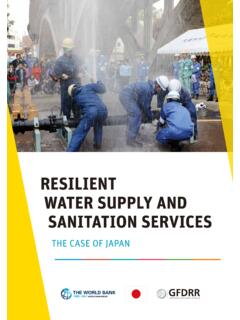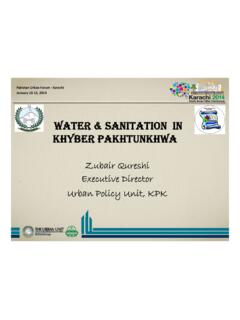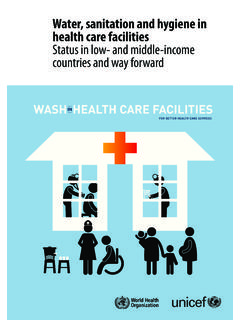Transcription of Interim Report - MIT
1 Designing water and sanitationprojectsto meet demandin rural and peri-urban areas- the engineer s roleInterim ReportPaul Deverill, Simon Bibby,Alison Wedgwood & Ian SmoutMarch 2001 water , Engineering and Development CentreLoughborough University, LeicestershireLE11 3 TUUK WEDC, Loughborough University, 2001 This publication is also available online at: document is an output from a project funded by the UK Department forInternational Development (DFID) for the benefit of low-income countries. The viewsexpressed are not necessarily those of and produced at WEDCA cknowledgementsThis document is very much the result of a collaborative particular, the authors wish to thank the Mvula Trust, Oxfam s Shinyanga UrbanWater supply and Environmental sanitation Project, NEWAH, and UNICEF sChild s Environment Programme in both Madhya Pradesh and Orissa, for theirparticipation in the field would also like to acknowledge the practical assistance provided by many otherorganisations and project partners, including WaterAid and WAMMA in Dodoma,Tanzania.
2 The Rural water supply and sanitation Development Funding Board inKathmandu, and the Gurkha Welfare Scheme in Pokhara, , we wish to thank the organisations and individuals who have providedfeedback on earlier drafts of this document and related documents, in particular,Dinesh Bajracharya from NEWAH, Dave Mather and Ned Breslin from WaterAidand Hugh Sussens from the Department of water Affairs and Forestry, South SummaryThis Report forms part of a DFID funded research programme investigating how waterand sanitation projects can be designed to meet demand. It follows a detailed literaturereview and field visits to project partners in South Africa, Tanzania, Nepal and India,bringing together the lessons that have been learnt and preparing the way for a set ofpractical meaning of demand and how it is expressed is at the centre of a largelyideological debate.
3 Achieving a balance between economic and social points of viewis important if the poorest users are not to be excluded. After due consideration, thefollowing definition has been adopted:Demand is an informed expression of desire for a particular service, measured by thecontribution people are willing and able to make to receive this contribution does not have to be monetary, but should be:! perceived by the potential user as affordable;! sufficient to empower the user as a consumer with associated rights andresponsibilities; and! related to the cost of the associated option, in order to facilitate the achievement ofcost recovery definition reflects the economic characteristics of effective demand.
4 It should bequalified by stating that the right to a basic level of service should not becompromised by meeting demands for higher levels of the theory, there are difficulties in developing and implementing a demandresponsive approach that can be used in practice. DRA, the demand responsiveapproach developed and advocated by the World Bank and the water and SanitationProgramme has been the subject of much debate. The Report examines people sconcerns in more detail, and in particular, its likely impact on the approaches used by six implementing organisations visited during the fieldworkare also reviewed. A number of key constraints are identified that combine to limit thechoice of service offered to households.
5 The importance of ensuring that the poor areable to participate in the process, and the need to meet future as well as currentdemand are also these points, the following set of principles is proposed that attempts todefine what meeting demand actually means:Principles of meeting demand1. Communities, households and individuals are enabled to make an informed choice of:! whether they want to participate in a project;! how services are to be allocated, managed, and maintained;! service level options;! how contributions are to be made and managed;(In practice, options will be limited not only by their absolute feasibility, but also by thecapacity of project staff and communities to deliver and sustain them).
6 2. Specific provision is made to ensure that marginalised groups are able to The right of all people to an affordable, basic level of service is not compromised;4. Systems for effective collective decision-making are established; and5. Facilities are designed and management systems are established which are capable ofresponding to future changes in principles are then applied to a project cycle (below left), describing theactivities associated with each step, and drawing on the work of the manyorganisations visited during the course of the fieldwork. Where necessary, additionalexamples have been included from a variety of other sources, including WaterAidprojects in Dar es Salaam and northern worked through the project cycle, furtherdetail is provided about the design process itself,focusing on the role of the engineer.
7 The process issummarized in the flow chart participation of the poor and the importance ofdesigning projects to meet future demand areemphasised throughout the Report . The latter shouldbe reflected in the infrastructure provided and themanagement systems established during ofpeople s prioritiesIdentification ofoptionsOption developmentDemand AssessmentPresentation of finaloptionsPreferred option(s)The project cycleThe design processThis process emphasises the need to treat potential users as clients, to focus efforts athousehold level, and to adopt a multi-disciplinary approach to project selection,design and implementation.
8 Particular expertise, skills and individual qualities areneeded by engineers, and these are identified in the terms of guidelines, a number of recommendations have been made. These aresummarised below: ! Guidelines should be focused on the engineer s role, but should be accessible toproject staff from other disciplines.! Guidelines should be generic but capture practical lessons being learnt by themany organisations collaborating in the project.! Guidelines will be in three sections: an introduction, details of the processesinvolved, and a summary of technical, financial and managerial options and theircharacteristics.! Many organisations are in a process of transition from being supply driven todemand responsive and have limited capacity.
9 This should be reflected in the styleand contents of guidelines, which will occupy the lower and middle rungs of theschematic ladder shown below.! A supplementary document may be produced pitched at the upper rungs of theladder. This will focus on more elaborate techniques used to access demand whichrequire specialist skills unlikely to be accessible to most involvement ofmen and women in projectdesign, through use ofparticipatory approachesUse of simple demandresponsive techniques includingparticipatory demandassessment for use in ruralsettlements and some peri-urbanMore complextechniques todetermine andrespond to userdemand, primarilyfor higher densityConventionalsupply drivenapproachThe ladder view of meeting demandContentsExecutive SummaryivList of is understood by demand?
10 Users with demand is and is DRA? of appraisal of in of principles implicit in meeting demand responsive project : where to work, who to work design people s priorities and marketing of service level for future , subsidies and options and negotiating , responsibilities and , sustainable monitoring and goal engineer s qualities and for or local guidelines? of local organisations to meet of approaches adopted by collaborating organisationsMvula Trust (South Africa) A-1 NEWAH (Nepal) A-2 RWSS Development Funding Board (Nepal) A-3 Shinyanga water and Environmental Health Project (Tanzania) A-5 WAMMA (Tanzania) A-7 UNICEF Child Environment Programme (India) A-8 References B-1 List of acronymsCBOC ommunity based organisationCVMC ontingent valuation methodologyDFIDD epartment for international developmentEHPE nvironmental Health Project (USA)IRCI nternational Reference Centre (Holland)KaRKnowledge and Research project (DFID funded)



















